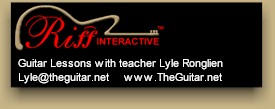
Jam Sessions - Funk
Style - Lesson 6
Lyle: Grab your guitar and
jam along! Join in on these jam sessions, which are designed to teach you theory
and technique, rhythm riffs, chords, scales, riffs, and solos, as you play along
to the jam tracks. Listen or watch the media clips below to see and hear what
you'll learn in this lesson:
Jam Sessions - Funk Style - Lesson 6
Jam Sessions -
Funk Style - Lesson 6

Lyle: Here's the jam track for this
lesson:
Jam Track
in F#7
chord
chart

Lyle: The
first rhythm riff is made from the minor pentatonic scale. I'm using a wah-wah
pedal, rocking it to the beat:
rhythm riff 1
rhythm riff 1
Support: Make sure you have the guitar neck
visible when you play back the notation, you will see the scale underneath the
lick being played.
Lyle: The first rhythm riff is made from the
minor pentatonic scale. I'm using a wah-wah pedal, rocking it to the beat:
Lyle:
The next riff is the arpeggiated chords of the jam track:
rhythm riff 2
rhythm riff
2
Lyle:
You can select the loop funtion for each of these TAB files so you can play
along to each riff. Once you can play the riff, try playing along to the regular
jam track.
Lyle: Rhythm riff 3 is a real easy and simple
riff. The hard part is making sure all the other strings don't ring or make any
noise:
mike:
What fingers should I use going from the A lick to the B7
rhythm riff 3
rhythm riff
3
Lyle:
mike, when you playback the TAB file and view it on the virtual fretboard, it
should display which fingers I suggest
using.
Skip:
What do they call that sound in rhythm riff 3?
Lyle:
Skip, those are octaves, two F# notes played an octave
apart.
Lyle: Rhythm riff 4 has you playing the chords
again like in rhythm riff 2, but this time way up high and using a beat that
doesn't get in the way of the other rhythms:
rhythm riff
4
rhythm riff
4
Lyle:
Here's another jam track that is just the 4 rhythm guitar parts, all playing at
the same time. Try playing any of the rhythm riffs along to this jam track or
use the other one with the drums:
Jam Track - just rhythm guitars
rat: The A
chord in riff 1 and 4 sure sounds like an F#m7, why call it an
A?
Lyle:
rat, you're right. The A maj and F#m are the same thing. It all depends on what
you perceive as the bass note of the
chord.
Lyle: I have in my mind the bass note shifting
there in the second measure to the A bass note, even though you don't hear it in
the recording. The chord I'm having you play is an inversion of the A major
triad.
Lyle: I have made a short solo that jumps around
to different scales against this simple 4 bar jam.
chord
chart

Lyle: Here's the first solo
riff:
solo - riff 1
solo - riff
1
Lyle:
Remember, you can loop each of the TAB files to help you learn it, try playing
along with me on each of these riffs.
Lyle: Notice in the chord chart that this
progression is in 2 different keys, F#7/B mjaor then the IV and V chords (A and
B7) of the key of E, then back to F#7/B major for the final 4th measure.
Lyle: It's fun to shift keys while
soloing. Notice the sound of solo - riff 1 changes as it goes into bar
two.
Miles: so
for this solo ur using a single vibrato pull
Lyle:
Same with the next riff, you'll hear it change keys slightly in bar
two:
solo - riff
2
solo - riff
2
Lyle:
The 3rd solo riff has you shifting from the F# Mixolydian, then to the E major
scale:
solo - riff
3
solo -
riff 3
Lyle: The 4th and final riff is simply
made from major pentatonic scales and following each chord:
Skip:
Lyle, if you had to learn the most important scales/modes, what would they
be?
solo - riff
4
solo - riff
4
Lyle:
Skip, I would say the major scale would be the first and most important scale to
learn, in every key, forwards and backwards, right-side up, and up-side down.
All the "church modes" come from the major scale. Learn the major scale and
you're learning 7 different modes at the same time, you just might not realize
it at the time.
Lyle: Here's a video of all 4 solo riffs played
in a row:
solo -
all 4 riffs
Lyle:
So a quick recap on what scales you might try along to the jam track. Use the F#
Mixolydian, F# major pentatonic for the 1st and 4th bars as well as the B major
scales:
F#
Mixolydian
F# major
pentatonic
Lyle:
F#7 is the V chord in the key of B major, which is why you can play the B major
scale against the F#7 chord!
B major scale
Lyle:
During the 2nd and 3rd measures, you're in the key of E major, so try using the
E major scale during those measures:
E major
Lyle:
You could also use the F# minor blues scale dirung bars 3 and
4:
F# minor blues
scale
rat: When I
play the E maj scale here in the middle of the progression during bars 2
and 3, I usually would think of this as an F# dorian....because it seems like
the F# is more dominant. Am I incorrect?
Lyle: E major and F# Dorian are the same notes,
just different starting points and different finger
patterns.
Lyle: Let's take a break here. Thanks everyone
for joing us live tonight! Hope to see you again. Have a good night, I need to
get going now, bye....